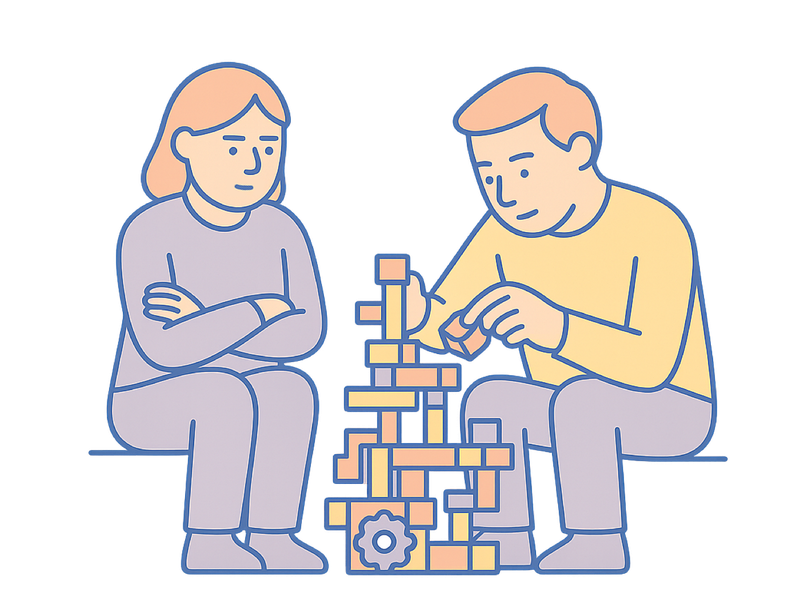Confessions of a Recovering Problem Solver
When the Best Support Isn’t a Solution.

Confessions of a recovering problem solver
Smudge is all about solving problems for people with software. And for a long time, problem solving was my default too. When someone shared their thoughts with me, I'd be looking for the problem and wondering what I could do to help.
It wasn't until I studied the book People Fuel by John Townsend that I consciously understood the idea that the first job we have in any human interaction is to help people feel seen.
That insight changed the way I relate. I’ve shifted my measure of success from solving a problem to wanting someone to feel seen. Often, when doing this well, we never get to problem solving. The reward of truly hearing and acknowledging someone’s life experience is more than enough.
Well-meaning problem solvers can prolong pain
In 2018, my marriage went through a difficult patch. My wife and I had been married for eight years when I decided to leave for what ended up being a period of around five months.
I didn't know what to do. I was lost and confused. And during that time, so many people had an opinion and sometimes even reached out to tell me what to do. They’d say, you should do this, or do that, or do what makes you happy. They all had different ideas.
These were people I trusted. So, their conflicting suggestions made life a whole lot harder than it needed to be. And everyone’s impulse to solve my problem made it difficult to have relationships during a period when I really needed support.
I simply needed to feel heard
Stu Braxton came into my life around that time, and his approach was quite different. He would sit with me and listen to my feelings without judgement. He would ask questions. He never once shared his perspective. He acknowledged my agency, accepted I didn't know the answers, and it would take time to make progress. As a result, he was able to help me navigate a situation with a myriad of relational, emotional, and intellectual complexities.
Stu’s approach was a marked contrast with the well-meaning people who cared for me, but who were trying to tell me what to do without asking about my feelings first.
Yet it wasn’t until I started practising the principles in People Fuel that I was able to see how important it was that Stu made me feel heard and consciously started doing that for people myself.
Functional conversations don’t build relationships
When my conversational default was problem solving. I wasn’t really listening to how people felt about a situation because I was too busy wondering how I could help.
I'd have these relational misses where something wasn’t fitting together and I didn’t understand what it was. I’d sense I wasn’t meeting the other person’s needs. People didn’t need help solving a problem, but I didn't know what they did want.
Now I try to walk alongside people and acknowledge their reality. I'm interested in their life, their feelings, and thoughts. And I no longer feel I’m missing the point of conversations. I’ve found a lot of joy in the intimacy of sharing in someone’s inner world.
When people do ask me to help solve their problem, I’ll now often ask more thought and feeling questions and acknowledge their reality of the situation first. Because often people know how to solve their own problem. They’re really asking for someone to witness their struggle.
Humans have a fundamental need for connection
However, it’s all too common for people to have had an experience where they’ve been vulnerable, someone has judged them and they’ve felt shame.
When that happens to people, they can be reluctant to expose their feelings in the same way. They can become functional in their relationships.
But being able to talk about feelings and emotional needs isn’t just a nice to have. It can be the difference between life and death. My dear friend Stu had the ability to give to so many people, but in the moments he needed it the most wasn’t able to receive or ask for the help that he desperately needed. What I would give to be able to provide for him now.
So, if someone indicates they don’t have a need for connection, ask a few gentle questions and try to learn why that is. Try and build some small common ground where you can make them feel seen. It might take months or years but it’s worth the work.
Make it safe to show emotion in the workplace
Peter Drucker has a well known saying, “culture eats strategy for breakfast”. I strongly believe that if we want a strong culture, we have to be comfortable expressing and accepting each other’s feelings. Doing that creates a transformational level of trust.
I’ve seen, including in our own team, how easy it is to skip over the feelings that come with failure or disappointment. But when those moments aren’t acknowledged, they tend to sit just under the surface. Over time, that can build up and start to shape behaviour. We can avoid risk and teams start to play it safe.
It makes a difference when someone feels they can say, “I’m disappointed that didn’t work out,” and have that met with genuine empathy. That sort of trust takes time, but it’s a real enabler for ambitious work, particularly when we know that innovation comes with setbacks and failures.
Experience relationships in full colour
When you start asking about people’s thoughts and feelings and being genuinely curious about their perspectives, you have richer conversations and build deeper relationships. For me, it’s been like seeing relationships in full colour, after a lifetime of black and white.
Learning to replace problem solving with listening has made me a better leader. And it’s also made me a better person, a better partner, and a better friend.
If your conversations are missing the mark, is it because you're trying to problem solve something that's relational? I invite you to ask more questions about the thoughts and feelings and enter into their reality.
I’m still working on being a great listener but when the time does come for problem solving I’ve got a lifetime of practice.
